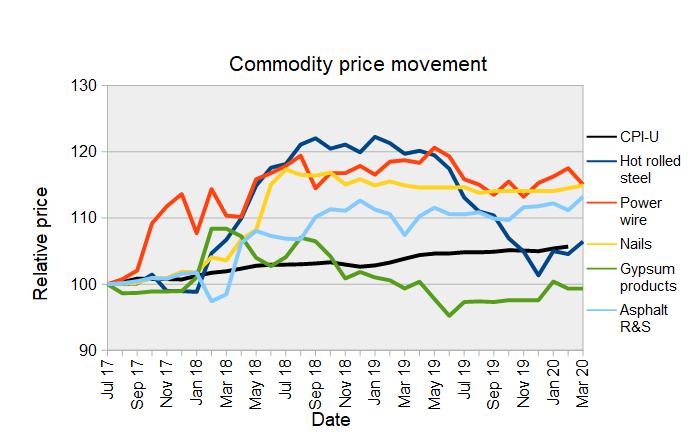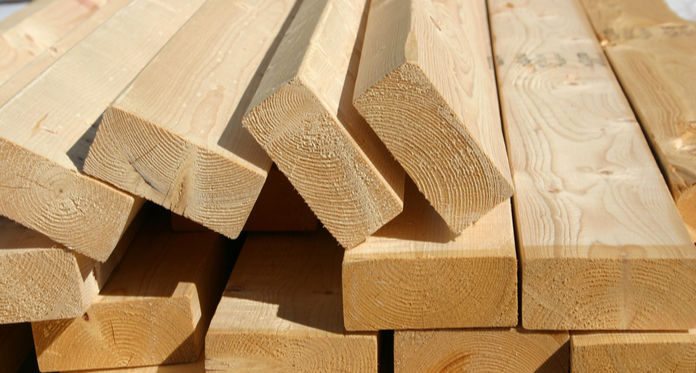The Bureau of Labor Statistics (BLS) released its producer price index report for March 2020. It showed that overall prices for processed goods for intermediate demand fell by 1.1 percent, the third monthly drop in a row. Falling energy prices again accounted for much of the decline with a 5.9 percent drop. Excluding food and energy, the price index for processed goods for intermediate demand was down by 0.8 percent for the month. The full index was 3.7 percent lower than its year-ago level.
By contrast, the BLS price index of materials and components for construction was up 0.5 percent from February, before seasonal adjustment. It was also 1.1 percent higher than its year-earlier level.
For reference, the changes in these indices compare with a 1.5 percent rise in the all-items consumer price index (CPI-U) for the 12 months ending in March and a 3.1 percent increase in average hourly earnings over that period.
Yield Pro (PRO) compiled the BLS reported price changes for our standard list of construction commodities. These are commodities whose prices directly impact the cost of constructing an apartment building. The two right hand columns of the table provide the percent change in the price of the commodity from a year earlier (12 Mo PC Change) and the percent change in price from January 2020 (1 Mo PC Change). If no price data is available for a given commodity, the change is listed as N/A.
| Commodity |
12 Mo PC Change |
1 Mo PC Change |
| Softwood lumber |
10.7 |
4.6 |
| Hardwood lumber |
-7.4 |
1.7 |
| General millworks |
2.1 |
0.7 |
| Soft plywood products |
-12.5 |
3.6 |
| Hot rolled steel bars, plates and structural shapes |
-11.3 |
1.8 |
| Copper wire and cable |
0.0 |
-1.4 |
| Power wire and cable |
-3.0 |
-2.1 |
| Builder’s hardware |
2.3 |
0.4 |
| Plumbing fixtures and fittings |
2.3 |
0.0 |
| Enameled iron and metal sanitary ware |
3.1 |
0.3 |
| Furnaces and heaters |
2.3 |
-0.9 |
| Sheet metal products |
-1.2 |
0.0 |
| Electrical Lighting fixtures |
7.5 |
0.4 |
| Nails |
0.0 |
N/A |
| Major appliances |
0.7 |
0.2 |
| Flat glass |
0.7 |
1.0 |
| Ready mix concrete |
4.7 |
0.5 |
| Asphalt roofing and siding |
5.4 |
1.8 |
| Gypsum products |
0.0 |
0.0 |
| Mineral wool insulation |
3.1 |
2.3 |
It was the surge in price of lumber products in late 2017 that first inspired this blog to be written. However, since peaking in the summer of 2018, lumber prices have come down well off of their highs. Recently, lumber prices have been rising, with the price of softwood lumber leading the way. While the prices of hardwood lumber and of soft plywood products are still down from their year-ago levels, they are both up for the last two months and seem to be accelerating. The second chart, below, shows the recent price history of several other construction materials whose prices increased rapidly in early to mid-2018. The price of hot-rolled steel has been the most volatile. After falling throughout last year, it has recently turned up sharply. This could be partly due to concerns about the impact of COVID-19, given that China is the world’s largest steel producer. The prices of the other construction materials tracked in this chart have been more stable recently. Note that the year-over-year price change of asphalt roofing and siding took a jump this month, but this was as much due to it being compared to an exceptionally soft March of last year as to a sudden increase in its price.
The second chart, below, shows the recent price history of several other construction materials whose prices increased rapidly in early to mid-2018. The price of hot-rolled steel has been the most volatile. After falling throughout last year, it has recently turned up sharply. This could be partly due to concerns about the impact of COVID-19, given that China is the world’s largest steel producer. The prices of the other construction materials tracked in this chart have been more stable recently. Note that the year-over-year price change of asphalt roofing and siding took a jump this month, but this was as much due to it being compared to an exceptionally soft March of last year as to a sudden increase in its price.
Price changes for several of the more finished goods from our sample are illustrated in the final chart, below. Electrical lighting fixtures again showed the largest annual price increase in this report with a rise of 7.5 percent, trailing only softwood lumber. However, electrical lighting fixture prices have been remarkably flat after surging last summer. Prices of furnaces and heaters also surged last year but have been more stable recently. The full BLS report.
The full BLS report.












